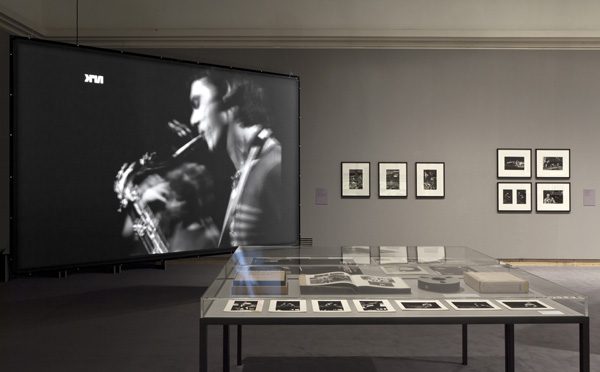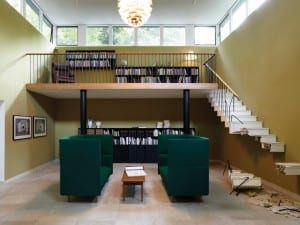Selected Signs is a collection of six disks featuring the music that was selected for the ECM exhibition, ECM – A Cultural Archaeology, at Haus der Kunst in Munich at the start of the year. The exhibition surveyed the record company’s significant creative work in the worlds of music, graphic art and photography over the past 44 years. Released 1 July, the recordings on Selected Signs formed part of the exhibition where visitors could listen to the tracks on headphones. Aesthetica speaks to Steve Lake, Production and Licensing at ECM Records, about the exhibition and his personal enjoyment of the album.
A: ECM Records has been running for 44 years and you have released albums across multiple genres – what would you say ECM’s “manifesto” is? What do you aim to do with music?
SL: Make the best possible recordings of musicians who deserve to be heard and then bring their work to the attention of a wider public. The music always comes first. Manfred Eicher’s particular background in jazz and classical music has brought an enhanced awareness of structure to very many recordings of improvisation as well as an “improvisational” flexibility to recordings of notated music. That’s part of the story, anyway – but, as you say, the label’s range runs across many genres now. Sometimes the most interesting music is found at the borders of the idioms.
A: How involved were you with the retrospective exhibition at Haus der Kunst, Munich?
SL: Since ECM’s history was the subject under discussion we were quite actively involved. We had many meetings and good talks with Haus der Kunst director Okwui Enwezor and his team, and worked closely with assistant curator Anna Schneider in going through thousands of photos, as well as films about ECM and its artists. We contributed ideas to the exhibition itself and had some input into the exhibition catalogue, for which I also did some writing.
With the support of Haus der Kunst, ECM also organized a very strong concert series, with performances by Jan Garbarek and the Hilliard Ensemble, András Schiff, Gidon Kremer, Tomasz Stanko, Charles Lloyd and Jason Moran, Evan Parker, Food, Enrico Rava, Tim Berne, Anouar Brahem, Nik Bärtsch, Stefano Battaglia, Meredith Monk, Anja Lechner, the Tarkovsky Quartet and more, all of this prefaced by the German premiere of Arvo Pärt’s Adam’s Lament. Then there was a film series curated by Manfred Eicher. And additionally: listening sessions, roundtable talks, and the creating of the “soundtrack” for the sound booths and the wall of headphones – this being the anthology now released as the Selected Signs box (most of which was Manfred’s work). These were some of our contributions.
A: Selected Signs features the music selected for the exhibition, are there any particular stand out songs on the album?
SL: There are too many to mention. Regarding the scope of the collection, Haus der Kunst focused its selection of visual exhibits primarily on the first 10 years of ECM and especially our documentation of avant-garde jazz. This was fine with us, and we were glad to see old friends like Don Cherry prominently represented. At the same time we wanted to show more of the label’s range in the audio material. So there is plenty of modern composition in the box set, going from Steve Reich to Pärt’s Fratres (with the unique combination of Gidon Kremer and Keith Jarrett) and Tabula Rasa, to György Kurtág, Tigran Mansurian, Valentin Silvestrov and Heiner Goebbels. There are extended sequences with Eleni Karaindrou’s music for film and theatre, featuring Kim Kashkashian and Jan Garbarek, and also with Jon Balke’s imaginative exploration of Andalusia with the voice of Amina Alaoui foregrounded.
I’m glad to have some instances of folk-inspired music included, by Frode Haltli, Sinikka Langeland and Robin Williamson. And of course there’s plenty of jazz and improvisation. The earliest recording is Jimmy Giuffre’s Jesus Maria from 1961 and the newest is a track from trumpeter Ralph Alessi’s forthcoming album. Don Cherry’s in there, too, playing Ornette Coleman’s music with the Old And New Dreams band. And so on. With more than 80 tracks and more than seven hours of playing time you might well “use it to soundtrack your own life”, as one reviewer recently suggested. The box by the way only exists in “physical” form. As an art object in its own right, it’s not available as a download, nor is it – or any other ECM recording for that matter – available from Spotify or similar streaming services.
A: ECM’s artistic endeavours go beyond music into graphic art, photography, film etc. what is the link between music and visual art? Why does ECM pursue other media?
SL: It’s always been part of the story of this label, and reflects Manfred Eicher’s interests in cinema, photography, painting and design. From the beginning the albums’ covers looked different from those of other record labels and as ECM’s sonic identity took shape a graphic language also slowly developed, helped along by creative designers including Barbara Wojirsch. A couple of books have been published about ECM cover art – “Sleeves of Desire” and “Windfall Light”, both issued by Lars Müller in Switzerland. And regarding film – Manfred’s had close contacts to directors including Godard, Bergman and Angelopoulos, and we’ve met many more filmmakers and theatre directors and choreographers as they’ve approached ECM for music for their work. A widening circle of influence has naturally brought the label into contact with artists of all kinds.
A: Over the years- have there been any musicians that you loved working with?
SL: The job can’t be done without affection, respect or empathy!
A: In an ideal world, are there any musicians, dead or alive, that you would love to work with?
SL: We quite frequently have to say no to living musicians we admire when there is no space in ECM’s production and release schedules, and because of ongoing commitments to so many great artists already on the label. I would say that on the whole we’re pleased with the musicianship on the more than 1300 albums recorded so far, while also keeping ears open for possible new developments …
A: How do you think ECM has developed over the years?
SL: Looking again at the list of musicians on Selected Signs it’s striking how many of them have been with ECM for decades – from Keith Jarrett and Jan Garbarek to Arvo Pärt, Kim Kashkashian, Eleni Karaindrou and Heiner Goebbels et cetera. The work continuing for such a long time without a need for long-term contracts – this is rather rare in the music business, and it speaks to the spirit of mutual trust that makes the label rather unique. And as ECM has grown an informed audience has grown up with it. Music on ECM has been a formative reference for a second generation of players – both jazz and classical – now recording for the label. Musically, the label is self-sustaining. Survival in the marketplace is another matter, and these are difficult times for just about everybody, but I do think that 44 years (so far) of artistic independence is an achievement.
For more info about ECM and to buy the album head to www.ecmrecords.com.
Credits
1.View of a room in the exhibition, with film image showing Jan Garbarek courtesy of ECM and Haus der Kunst Munich.
2. Selected Signs, courtesy of ECM.





